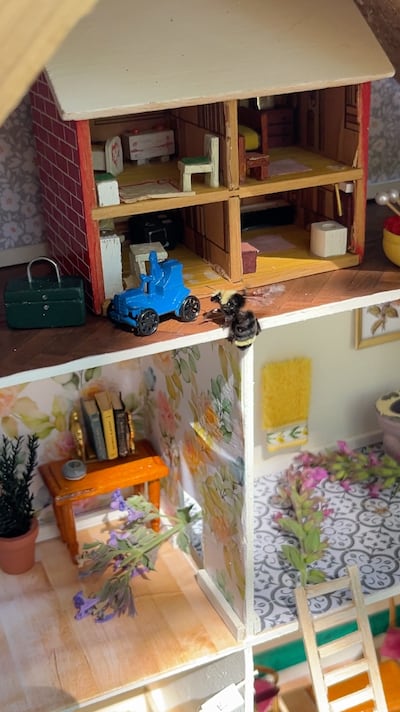The corner of Southeast 78th Avenue and Morrison Street is a must-visit for children in the Montavilla neighborhood. OK, and their parents. What started as a dinosaur figurine exchange in 2022 has blossomed into a full-on sidewalk art installation of miniatures.
The Dino Exchange is still thriving, alongside the PDX Dinorama, a little purple house of six dioramas of dinosaurs doing things like riding bikes, playing instruments, and having a tea party. There’s a Teeny Tiny Little Free Library with a shelf of real, thumb-sized books—not to be confused with the Ultra Tiny Free Library, which is even smaller. There are fairy footprints on the sidewalk, a lot of bee content (more on that later), and even a “squirrel station” that gets restocked with nuts.
The creator of all this magic—a movement now, really—is Rachael Harms Mahlandt. One gorgeous autumnal Mount Tabor morning, a woman visitor (no children in tow) was walking back to her car when she realized Harms Mahlandt, the artist, was right there on the sidewalk.
“I love this so much. It almost makes me want to cry. I left two dinos!” and she was off.
During the pandemic, Harms Mahlandt was looking for outdoor, distanced ways to keep herself and her two young children entertained. She spent some of those long, blank afternoons traveling around to different DIY garden toy and art spots. They called themselves the Urban Explorers Club and wore little badges and everything.
“I loved that feeling we got every time we found one of these places,” she says. “It was a totally unexpected little bit of whimsy, and my kids were entertained by it.”
Once Harms Mahlandt got PDX Dinorama up and running, she started promoting it and other Portland spots on Instagram. Eventually, that grew into her creating a guide map to all of these free, interactive yard installations called PDX Sidewalk Joy, along with Grant Brady of PDXFLAG (Portland Free Little Art Gallery). There are about 100 sites now, including the Rose City Puzzle Library, Montavilla’s Little Free Greenhouse, and Irvington’s Tiny Creature Swap, which was also created by and for kids during the pandemic. They meet twice a year.
Harms Mahlandt had recently taken up home improvement (“when people were making sourdough, I learned how to use power tools”), so the project came at just the right time for her to use her new skills. Harms Mahlandt’s background in professional photography and marketing for small businesses and nonprofits turned out to be a killer combination for knowing how to create and promote social media content.
But Harms Mahlandt reached a whole new level of internet fame this summer when she met Harriet the Bee. In July, she noticed a flightless little bumblebee at the bottom of a bucket in her garden. She had one malformed wing and couldn’t fly, so Harms Mahlandt and her children put her in a Tupperware container with no lid. They asked a neighbor for some of their flowering catnip, and Harriet buried her face in the flowers. With Harriet sated, they brought her inside to figure out their next move.
“I figured we can do better than this Tupperware,” Harms Mahlandt says. “We can make her a nice little environment.”
Did they ever. Just a day later, Harriet had her own “AirBeeNBee,” a three-story tiny home. (Harms Mahlandt had all the materials on hand from PDX Dinorama projects, plus “if you look closely, you’ll see it’s not perfect.”) Harriet had her own bedroom, complete with photos of herself on the wall, bookshelves, and a dirt bed with little “welcome” flags above it. On the first day, Harriet explored only the first floor, but by the second in her new home, she figured out how to climb the ladder Harms Mahlandt had constructed for her to reach the bathroom and parlor. Eventually she even got up to the attic to see her toys (the dollhouse within the bee house is “very meta,” Harms Mahlandt says).

The Instagram post went bananas, with almost 300,000 likes.
Two days later, Harms Mahlandt shared a video of her field trip with Harriet to McMenamins Edgefield Gardens, where they met with a gardener. They learned that Harriet was a yellow-faced bumblebee who had probably been shunned from her colony (or left on her own) for being flightless. Also, that wasn’t one malformed wing: Both wings were simply torn up and ragged, a sign of old age in bees.
The very next day, Harms Mahlandt posted a final Harriet update. “I am devastated,” it began. The bee had died.
After Harriet’s death, someone in the United Kingdom was inspired to plant their own pollinator garden while two other followers wrote bee poems. People rescued other bees in Harriet’s honor when normally they would have been too afraid of getting stung.
“Hearing stories about how Harriet affected people worldwide has been life-changing,” Harms Mahlandt says. “I just sobbed.”
While Harriet is no more, her legacy lives on as Harms Mahlandt has gone all in on bee education and habitats. Next up: She plans to give away mason bee homes and larvae this winter, and she’s in conversation with an urban beekeeping organization to start her own hive.
Harms Mahlandt had been in the middle of building a heart-shaped pollinator garden when Harriet died, so she finished that project in hopes of attracting more bees to her garden (and the AirBeeNBee is ready to go in her workshop, should another winged friend need it). Other tributes include an informational “Bee Stop” with a painting of Harriet on the back and seed packets and zines about bee care on shelves inside.
There’s even a bee diorama of a fuzzy bee alit on a rainbow of flowers. A sign reads: “Rest in Pollen Sweet Harriet.”

